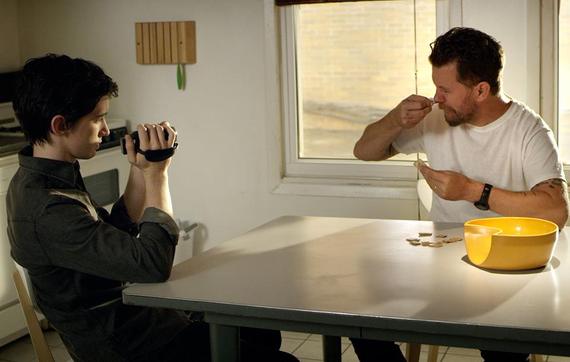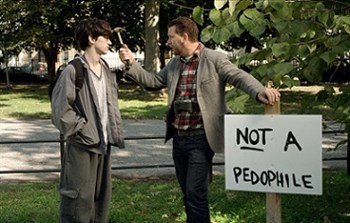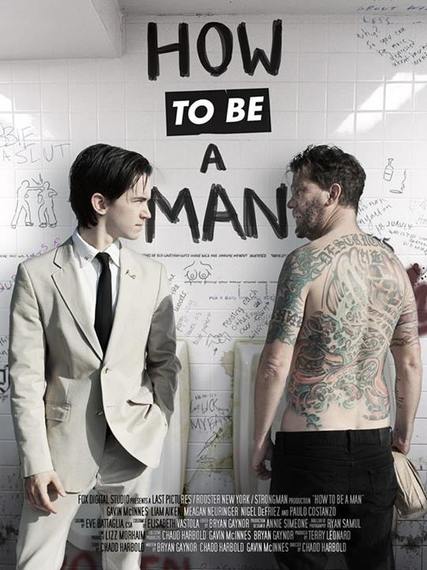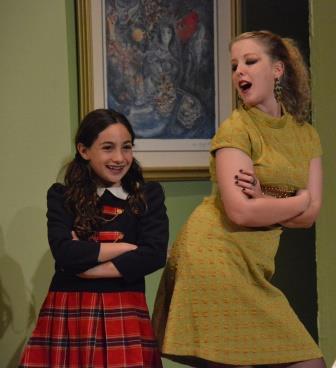Comedians love to test an audience by pushing the envelope. Push hard and, if you get a good laugh, push even harder. Keep pushing as you test the crowd to see how far you can go without completely alienating people. For someone like Scott Capurro, that's simply doing what comes naturally.
Born in Saudi Arabia to Bangladeshi parents who eventually settled in Australia, Aamer Rahman is a master of this technique. Though he graduated from college with a law degree, Rahman's comedic skills have made him internationally famous.
Getting away with murder is a prerequisite for comedy writers with an edge. In the following two clips, Gavin McInnes doesn't hesitate to use his children -- quite hilariously -- as props for his outrageously iconoclastic videos.
McInnes is the driving force behind a rude, crude, and gut-bustingly funny new film entitled How To Be A Man (which was screened at the 2014 SFIndie Film Festival). In this film, McInnes plays Mark McCarthy, a highly dysfunctional married man whose wife, Margot (Megan Neuringer), is expecting their first child.
Eager to be a good father (and feeling increasingly inadequate as his child's birth approaches), Mark puts an ad up on the Internet looking for someone who can film him making video messages for his future son to watch. Why? Having felt a lump in his chest, Mark is convinced that he's dying of breast cancer and hasn't got long to live.
Liam Aiken and Gavin McInnes in How To Be A Man
Enter Bryan (Liam Aiken), a young film student whose mother (Marisa Redanty) sees Mark's online ad and recognizes him as an old flame from her wildly adventurous, slutty youth. Soon enough, Bryan is filming Mark as he tries to explain to his boss at an advertising agency how and why fart jokes move product.
As Mark sinks deeper and deeper into alcohol- and drug-induced trouble, he coaxes Bryan to join him in pursuing the carnal joys of booze, weed, coke, sex, and heroin as they continue making short films. Absolutely nothing is sacred to McInnes and, if you're the slightest bit offended by his twisted sense of humor, I'd suggest you stick to watching films about Disney princesses.
As Mark realizes how naive Bryan is, he tries his best to give the young videographer a crash course in how to lead a wild and crazy life. Some of the funniest scenes (which might strike some viewers as misogynistic) range from an extended solo in a bar where Mark lectures Bryan about the fine art of cunnilingus to some practical tips on the bare necessities of scoring cocaine (if need be, whip out your dick to impress the dealer).
Liam Aiken and Gavin McInnes in How To Be A Man
So many moments in How To Be A Man reminded me of 1982's My Favorite Year (in which Peter O'Toole played a wildly out-of-control mentor to a young and impressionable Mark Linn-Baker) that it didn't take long for me to fall in love with this film. As coming-of-age stories go, it's infinitely more grungy, its protagonist is far more pathetic, and its humor as black as tar and as perverse as possible.
Poster art for How To Be A Man
In supporting roles, Dana Watkins tries to be the voice of reason as Mark's boss at the advertising agency while Nigel DeFriez appears as Felix (Bryan's pretentious dick of a roommate). Paulo Costanzo does superb work as Gary (a recovering addict and former drug dealer who has gotten clean and is working as a waiter when the ever-resourceful and devilishly manipulative Mark tracks him down for a favor).
How To Be A Man is not the kind of film you watch for "safe" comedy (there's a glorious stunt where Mark's pregnant wife is beating him with a baseball bat as her bag of waters breaks). Here's the trailer:
* * * * * * * * * *
Set in the stylish home of a highly dysfunctional family preparing to celebrate Thanksgiving, Bruce Norris's energetic black comedy entitled The Pain and the Itch begins with an awful lot of screaming. There's even a revelatory moment in Act II during which the audience breathes a collective sigh of relief to learn that the stay-at-home father of a young girl is not a repressed pedophile.
Directed by Dale Albright, Custom Made Theatre Company's production of this play unfolds on a handsome unit set designed by Stewart Lyle. A highly economical piece to produce (one set, seven actors), The Pain and the Itch focuses on a family whose patriarch insists that they are not rich. As in the wise words of Fox Business Network news anchor, Tracy Byrnes: "$250,000 is not rich for a family of four sending kids to college. It actually is close to poverty."
Brothers Cash (Peter Townley) and Clay (Justin Gillman) in
The Pain and the Itch (Photo by: Jay Yamada)
- Clay (Justin Gillman) is a modern-day house-husband and control freak who, as much as he hates his older brother (a plastic surgeon), is willing to invite him over for Thanksgiving dinner in order to get a free second medical opinion and a prescription for the alarming genital rash discovered on his daughter, Kayla (Gabriella Jarvie).
- Kelly (Karen Offereins) is Clay's wife, a high-earning attorney nursing her second child. A competent professional woman who is the obvious breadwinner in the family, Kelly (who detests President George W. Bush and his arrogant Republican followers) tends toward an upper middle class version of political correctness -- especially with regard to anything that affects her children.
- Carol (Jean Forsman) is Clay's ditzy and forgetful mother who votes for the Socialist Workers Party and loves to watch PBS, but often lapses into baby talk when addressing her eight-year-old granddaughter. There has never been any doubt that she favored Cash (short for Cassius) over Clay throughout their lives.
Carol (Jean Forsman), Kalina (Eden Neuendorf), and Kelly
(Karen Offereins) in The Pain and the Itch (Photo by: Jay Yamada)
Helping to ruin Clay's tightly-wound sense of self-importance are:
- Cash (Peter Townley), his older brother who used to bully him. A successful plastic surgeon, Cash doesn't hesitate to call his Russian girlfriend (who has some problems with English as a second language) a nitwit. Less impassioned and more realistic than Clay, he once refused to take on a potential client who wanted a facelift but began her intake interview by describing how she was morally opposed to plastic surgery.
- Kalina (Eden Neuendorf), Cash's immigrant girlfriend who grew up in poverty, was raped in her youth, and sees America as a land of opportunity.
- Mr. Hadid (Dorian Lockett), a Muslim taxi driver whose wife went into a diabetic coma when police arrested her after she had taken her insulin but refused to give her any food. Although it's not quite clear why Mr. Hadid has been invited to Thanksgiving dinner, he shows a remarkable curiosity about the financial value of Clay and Kelly's belongings.
Kalina (Eden Neuendorf) plays with young Kayla (Gabriella Jarvie) in
The Pain and the Itch (Photo by: Jay Yamada)
While the initial conflict in Clay and Kelly's home stems from the chaos created by Kalina chasing Kayla around the house, the longstanding sibling rivalry between the two brothers, Clay's fear that rodents may have invaded the premises, and the fact that whenever Carol tries to watch television with her granddaughter she finds the device tuned to a porno channel instead of PBS, there are deeper, darker secrets waiting to be revealed. In 2006, when The Pain and the Itch had its world premiere in Chicago, Steppenwolf Theatre Company's artistic director, Martha Lavey, explained that:
"The Pain and the Itch provides a familiar landscape: a middle-class family (their precise socioeconomic status a matter of dispute within the play) in a single-family home in present-day New York. This is a white family, issued up as the normative American experience. In a nod to the contemporary landscape of shifting gender roles, Kelly (wife and mother) is the principal breadwinner. Her husband, Clay, is the stay-at-home childcare provider. Carol and Cash occupy a more traditional distribution of gender roles and define the patriarchal structure against which Clay has re-made himself. Clay's is an uneasy self-invention: he is quick to claim his competency as a father and defensive about his wife's implied (and explicit) criticism of his caretaking. It is important to Clay that parenting be recognized as a job -- a hard job -- and, finally, the most important and serious job of all. Anything that threatens the absolute seriousness and sanctity in which family is held is subject to attack.
Despite Clay and Kelly's furious attempts to create an oasis of health, gender equity, and nonviolence (all of the politically correct ideals of the white, urban upper-middle-class milieu that they occupy -- however sheepishly), it is an anxious home. The members of its extended family are a threat, outsiders are a threat, the house alarm system is activated (by the master of the house) and cannot be disabled. Clay and Kelly, confident of their impeccable credentials and intentions as parents, immediately assume that they are under threat from outside sources. Their righteousness makes self-reflection impossible. The presence of immigrants -- Kalina, of Eastern European extraction, and Mr. Hadid, a North African -- produces another template of dissonance. Kalina and Mr. Hadid are others who express points of view and needs that conflict with and threaten the intact circle of Clay and Kelly's life."
Dorian Lockett as the taxi driver, Mr. Hadid in
The Pain and the Itch (Photo by: Jay Yamada)
There's no doubt that Norris (whose 2010 play, Clybourne Park, earned him a Pulitzer Prize for Drama) is a formidable writer with an acid wit. However, two very specific structural problems hovered over the Custom Made Theatre Company's production.
- Because The Pain and the Itch is told in a series of flashbacks, a change in lighting is often used to denote the switch from the present to the past (these flashbacks are usually triggered by questions from Mr. Hadid). This may have been more difficult for the audience to follow because, unlike a traditional stage with a proscenium, the Custom Made Theatre Company employs a 3/4-round seating style. In some ways, I felt this may have weakened the surprise ending Norris crafted for his play.
- The way The Pain and the Itch is scripted, the two most demanding roles (Clay and Kalina) require much stronger actors than the smaller roles. While I was particularly impressed with the performances by Justin Gillman and Eden Neuendorf, the sheer physicality of their work put the supporting cast at a clear disadvantage.
To read more of George Heymont go to My Cultural Landscape







